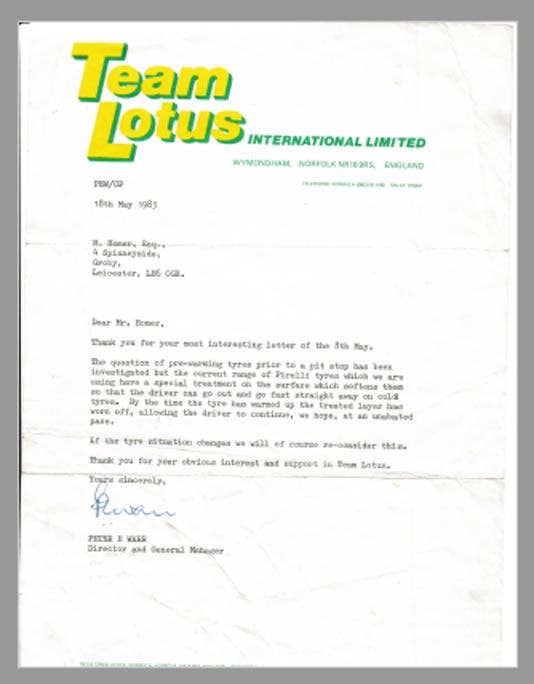Tire Warmers
Cold tires are the enemy of the racing driver, so it's no surprise that teams go to great lengths to heat up the rubber to give the tires grip as soon as they touch the asphalt.
Credit for inventing the tire warmer goes to one Mike Drury, who take his inspiration during 1985 European Grand Prix at Brands Hatch. On his corporate website Drury explains: "It was November and very cold and I saw that the teams were trying to keep the cars' tires warm by wrapping them in blankets and duvets. It occurred to me, since I was already in the business of making weatherproof jackets and anoraks, that here was an opportunity for a more creative approach." Drury's creative approach eventually bore fruit, after time spent convincing the teams that a technological approach to tire temperatures was the way forward.
But first attempt to heat the tires was recorded 1974 during 1974 GP of Canada which took place in September. As is normal in Canada in the autumn, conditions outside were somewhat chilly. The early part of the weekend saw drivers struggle for grip, and there were concerns that on the race start, tires might actually separate from their rims. McLaren find the way by converting their pit into a heated shed that would keep the tires warm so they could withstand higher internal pressure. But there was still the problem when they bring the tires on the grid. The low temperatures would cool the tires negating effect from the heated pit. The answer was found in the team's hotel. Duvets and blankets were requisitioned from the beds, wrapped around the still-hot tires on the grid to kept them warm.
Emerson Fittipaldi took the checkered flag that afternoon, having started on pole, and the concept of warming the tires entered F1, even if it took a few more years for the technology to be perfected. Which lead as back to Mike Drury.
The system that teams are using is very simple. A control box allows the tire technician to set the temperature. Power then flows trough the wires to the blankets, which are wrapped around the tires. Heating elements in the blankets are surrounded by a heat conductive gel, which heats the surface of the rubber to in excess of 100 degrees C.
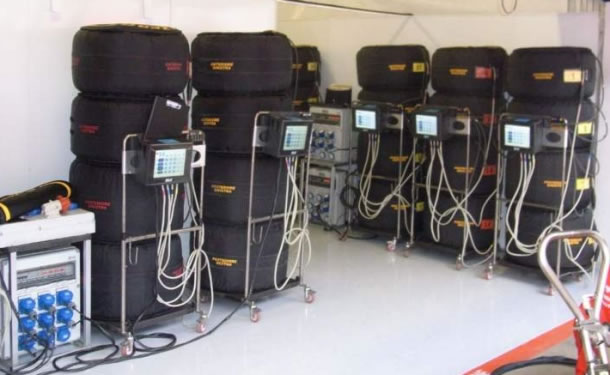
Basically, they wrap up the tires in the heating blankets, stack them up, plug them in and they're subjected to a constant heat until they are turned of by thermo regulating elements or by technician responsible for tires.
All clear, you think. But just consider that each tire needs to be heated for a minimum of two hours, and that numerous types of tire must be heated and on hand.
The warmer the tire, the more grip the driver has. Watch a re-start after the Safety Car has pulled into the pits and you'll see that for yourself.
Rubber temperature also influences the pressure of the tire. Pressure is as important as grip. If the pressures are low, the car will sit lower down. That makes a softer ride, whereas higher pressures make a stiffer ride. The race engineers will often request a pressure adjustment during setup, along with a mechanical change.
With so much importance placed on tire temperature, it is no surprise that technicians and the team constantly monitor the control box to make sure everything is going to plan.
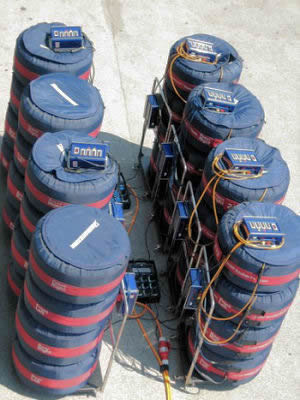 |
BMW Sauber F1 Team tire warmers and control box in the middle. |
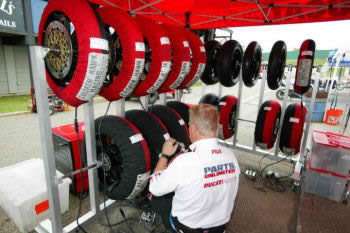 |
Ducati MotoGP wheels on rack wrapped with tire warmers |
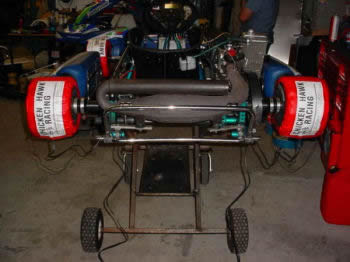 |
Kart Tire Warmers |
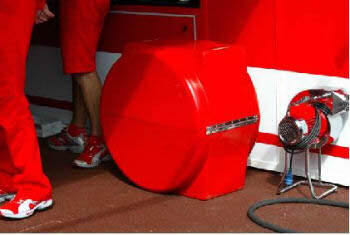
During June 2005, there was more controversy in pitlane.
FIA's rule states that only a tire blanket may be used to keep the tires warm when the car is not running. Tire ovens, which can heat the tire more evenly, are not allowed. But, Ferrari finds a hole in the rules, and interpreted it in their own way.
Ferrari had a problem all year 2005. Their tires do not perform well during the first few laps. The tire starts to perform well only when it is heated evenly after a few laps. Qualifying and start was compromised!
Ferrari finds solution and they put a tire, together with tire blanket in a box and are using it in that way. That provides better heating than a traditional blanket in open air by heating the rims too. Basically, heat produced by heating blanket doesn't escape and is all contained inside the box providing more uniform heating. FIA seems to have checked it and decided that it is not a tire oven and approved it.
Ferrari has been using this solution since 2005 Monaco GP. They have seen better qualifying performances with the new device. The other teams have noticed this and are objecting to the tire heating box. Some are investigating in building their own boxes. Finally FIA decided to put a ban on this solution.
A couple of days ago I received an interesting email from Mr. Michael Homer. I think you will find it interesting as well. It indicates some things that were previously unknown, at least to me.
|
Formula 1 Tire Suppliers - History
Tire Compouns
Tire Warmers
Using Tires
What is the most important part of a racing car?
Back to the top of the page

